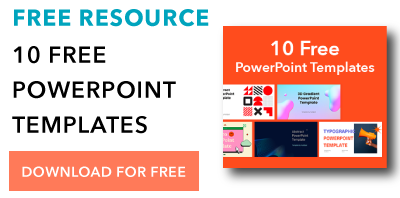We use presentations every single day to tell stories, pitch ideas, share data, and even connect with our audience. But, there’s a small problem: 32% of people have fallen asleep during a PowerPoint presentation.
And that's not really that surprising. Though marketers slave over writing personable emails, engaging blog posts, and perfectly crafted tweets, when it comes to creating slide presentations, autopilot switches on. We’re satisfied with PowerPoint templates straight out of the 90s, Times New Roman fonts, and bullet points -- a combination more powerful than Nyquil.
→ Free Download: 30 PowerPoint Presentation Templates [Access Now]
The bottom line is that design matters. Regardless of how dynamic the speaker, mind-blowing the statistics, or captivating the idea, boring PowerPoint slides could make your audience fall asleep -- fast. Below are six reasons why people are snoozing off during your presentation and some design tips you can use to prevent that from happening again.
(P.S. If you want some beautiful, easy-to-use PowerPoint presentation templates that'll help keep your audience awake, you can get them here.)
1) We Use a Scary Amount of Text
Garr Reynolds, author of best-seller Presentation Zen, coined the term 'slideument' to describe what happens when you try to merge a written document and a slide. In reality, we just call this a headache. Accoring to a SlideRocket surve y, one of the top frustrations people have with PowerPoint presentations is that there's 'too much text,' yet a lot slides we see still look like larger-than-life index cards.
When it comes to PowerPoint slides, elements like graphs, fonts, colors, images, and layouts speak louder than the writing on the wall. Literally. The fewer the words on the slides, the better.
2) We Keep Saying, “I’m Not a Designer”
Instead of taking a few minutes to explore PowerPoint's toolbar or Google a few tips, we've developed this bad habit of justifying boring slides with, "I'm not a designer." You don’t have to know Photoshop or be tech-savvy to create sleek slides; there are countless, quick techniques you can do right in PowerPoint to spruce them up. Next time you have a free 15 minutes, open up PowerPoint and try to recreate a slide that caught your eye on SlideShare, at a conference, or even from memory.
While PowerPoint has a slew of versatile tools, there are countless, free web-based applications created specifically for the non-designer. Sites like Canva can help you generate professional-looking visuals using your custom content.
Now, instead of asking a colleague to make your slides look "pretty," you can take visual content into your own hands. With access to PowerPoint how-tos and free visual content tools, it's never been easier to solve the lack-of-designer problem.
3) We Stick to What Fonts We Know
Do you think Van Gogh would have gone down in history as an artistic genius if he had stuck to the primary colors? I doubt it. He blended colors to create beautiful hues and shades that brought his paintings to life.
PowerPoint default fonts like Tahoma and Arial are like primary colors. We've been using these standard typefaces in our slides for years; they aren't just familiar, they're antiquated.
Check out the two fonts below. Which catches your attention first? Which one looks more sophisticated? You're probably more drawn to the text on the right-hand side because it's a premium font. Just because the left-hand font, Calibri, is already available in PowerPoint, doesn't mean you should rely on it.
Spice up your slides by adding premium fonts to your palette. There are tons of websites you can visit to download custom fonts for free, like FontSquirrel or Google Fonts. (Need more help getting started with premium fonts? Click here to watch a how-to video on downloading and installing fonts for PowerPoint.)
4) We Don't Know a Bad Image When We See It
We already know that the key to a successful presentation is telling your story through visuals ... but not all images are created equal. Most people have caught on that clipart is a presentation faux pas. (I hope.) But, we're still using cheesy stock photos, low-quality images, and unrelated illustrations that portray our content as amateur. We need images that make us look like the savvy, cutting-edge marketers that we are.
Now, I know finding gorgeous images has never been easy. Subscription sites like ShutterStock and iStock don't always agree with our budgets and reading the usage rights on free photos can be a headache. But, there are a few Robin Hoods out there who share beautiful, high-quality photos for free download. I have this Medium post, Stock photos that don't suck, bookmarked in my browser; it features a list of sites that put pay-to-play platforms to shame.
So next time you're putting together a slide deck, keep in mind that a picture's worth a thousand words. Luckily, top-notch ones don't have to be worth a thousand bucks.
5) We Think Bullet Points Are Magic
As soon as bullet points flash on the screen, the audience starts daydreaming or playing Angry Birds (don't lie, you've done it). We think bulleting our content will make it easier for people to absorb, when in reality, it makes it harder for them to stay awake. The solution to the 'too much text' problem isn't condensing every paragraph into bullet points -- it's embracing visual elements.
What's worse is why we use bullet points. Often, people use them as a crutch for remembering their slides. But if you can't remember your own content, then why should your audience?
I think David Meerman Scott puts it best, "When I see bullet points on someone’s slides, I immediately think they don’t know the material and are using the slides as a teleprompter. Use images and video instead for maximum impact. But first, rehearse, rehearse, rehearse, (and then rehearse again)."
Bullet points can be a great way to outline your presentation, but when actually presenting, make sure they're gone from your deck. Remember, no one's going to say, "I wish that presentation had more bullet points."
6) We're Not Inspired
A huge problem with most presentation decks is that they're uninspired. Seth Godin was onto something when he said, "PowerPoint could be the most powerful tool on your computer. But it’s not. Countless innovations fail because their champions use PowerPoint the way Microsoft wants them to, instead of the right way."
When we're stuck writing a blog post, we look to bloggers we admire to get the wheels turning. We don't really seek out amazing SlideShares or look to world-class speakers to kick start the slide process -- but we should. By getting familiar with what a captivating presentation looks like, it'll be easier to create one of your own.
Steve Jobs was known for being a presentation master. Countless articles, blogs, and books use him as an example when sharing tips on giving an effective talk. A huge factor in his speaking success was that his slides reflected the same idea that pioneered Apple: simplicity. At every keynote product launch, Steve's slides were as sleek as the iPhone, iPad, or iPod he was talking about.
Are you looking to dive into some design inspiration? Check out decks from charity: water and SlideShare presentations from Eugene Cheng. These experts always push us to step our slide game up.
Slide platforms like PowerPoint haven't changed much over the years, but marketing has -- and our presentations need to follow suit. Not only do beautiful slides keep audiences awake and engaged, but they also give you and your business more credibility. So do your audience a favor and avoid these mistakes, okay? By avoiding these mistakes, your presentation will be much more valuable than a nap.

Presentations



![PowerPoint Tips to Present Like a Pro [Expert Advice & Free Templates]](https://53.fs1.hubspotusercontent-na1.net/hubfs/53/powerpoint-design-tricks_7.webp)

![20 Great Examples of PowerPoint Presentation Design [+ Templates]](https://53.fs1.hubspotusercontent-na1.net/hubfs/53/powerpoint-presentation-examples.webp)
![How to Create the Best PowerPoint Presentations [Examples & Templates]](https://53.fs1.hubspotusercontent-na1.net/hubfs/53/powerpoint.webp)



![How to Start a Presentation [+ Examples]](https://53.fs1.hubspotusercontent-na1.net/hubfs/53/how-to-start-presenting.webp)

